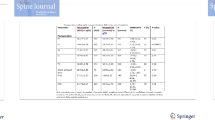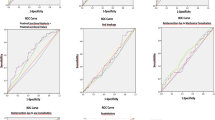Abstract
Purpose
Analysis of interactions of spinal alignment metrics may uncover novel alignment parameters, similar to PI-LL. This study utilized a data-driven approach to hypothesis generation by testing all possible division interactions between spinal alignment parameters.
Methods
This study was a retrospective cohort analysis. In total, 1439 patients with baseline ODI were included for hypothesis generation. In total, 666 patients had 2-year postoperative follow-up and were included for validation. All possible combinations of division interactions between baseline metrics were assessed with linear regression against baseline ODI.
Results
From 247 raw alignment metrics, 32,398 division interactions were considered in hypothesis generation. Conceptually, the TPA divided by PI is a measure of the relative alignment of the line connecting T1 to the femoral head and the line perpendicular to the sacral endplate. The mean TPA/PI was 0.41 at baseline and 0.30 at 2 years postoperatively. Higher TPA/PI was associated with worse baseline ODI (p < 0.0001). The change in ODI at 2 years was linearly associated with the change in TPA/PI (p = 0.0172). The optimal statistical grouping of TPA/PI was low/normal (≤ 0.2), medium (0.2–0.4), and high (> 0.4). The R-squared for ODI against categorical TPA/PI alone (0.154) was directionally higher than that for each of the individual Schwab modifiers (SVA: 0.138, PI-LL 0.111, PT 0.057).
Conclusion
This study utilized a data-driven approach for hypothesis generation and identified the spino-pelvic ratio (TPA divided by PI) as a promising measure of sagittal spinal alignment among ASD patients. Patients with SPR > 0.2 exhibited inferior ODI scores.
Level of evidence
III.





Similar content being viewed by others
Code availability
SAS 9.4, Julia 0.6.4, R 3.5.0
References
Pellisé F, Vila-Casademunt A, Ferrer M, Domingo-Sàbat M, Bagó J, Pérez-Grueso FJ, Alanay A, Mannion A, Acaroglu E, Group ESS (2015) Impact on health related quality of life of adult spinal deformity (ASD) compared with other chronic conditions. Eur Spine J 24(1):3–11
Ames CP, Scheer JK, Lafage V, Smith JS, Bess S, Berven SH, Mundis GM, Sethi RK, Deinlein DA, Coe JD (2016) Adult spinal deformity: epidemiology, health impact, evaluation, and management. Spine Deform 4(4):310–322
Fu K-MG, Bess RS, Schwab FJ, Shaffrey CI, Lafage V, Smith JS, Akbarnia BA, Ames CP, Boachie-Adjei O, Burton DC (2012) Health impact comparison of different disease states and population norms to adult spinal deformity (ASD): a call for medical attention. Spine J 12(9):S2
Schwab F, Dubey A, Pagala M, Gamez L, Farcy JP (2003) Adult scoliosis: a health assessment analysis by SF-36. Spine 28(6):602–606
Bess S, Line B, Fu K-M, McCarthy I, Lafage V, Schwab F, Shaffrey C, Ames C, Akbarnia B, Jo H (2016) The health impact of symptomatic adult spinal deformity: comparison of deformity types to United States population norms and chronic diseases. Spine 41(3):224
Schwab FJ, Blondel B, Bess S, Hostin R, Shaffrey CI, Smith JS, Boachie-Adjei O, Burton DC, Akbarnia BA, Mundis GM (2013) Radiographical spinopelvic parameters and disability in the setting of adult spinal deformity: a prospective multicenter analysis. Spine 38(13):E803–E812
Schwab F, Ungar B, Blondel B, Buchowski J, Coe J, Deinlein D, DeWald C, Mehdian H, Shaffrey C, Tribus C (2012) Scoliosis Research Society—Schwab adult spinal deformity classification: a validation study. Spine 37(12):1077–1082
Zygourakis CC, Liu CY, Keefe M, Moriates C, Ratliff J, Dudley RA, Gonzales R, Mummaneni PV, Ames CP (2017) Analysis of national rates, cost, and sources of cost variation in adult spinal deformity. Neurosurgery 82(3):378–387
Smith JS, Lafage V, Shaffrey CI, Schwab F, Lafage R, Hostin R, O’Brien M, Boachie-Adjei O, Akbarnia BA, Mundis GM (2016) Outcomes of operative and nonoperative treatment for adult spinal deformity: a prospective, multicenter, propensity-matched cohort assessment with minimum 2-year follow-up. Neurosurgery 78(6):851–861
Bridwell KH, Glassman S, Horton W, Shaffrey C, Schwab F, Zebala LP, Lenke LG, Hilton JF, Shainline M, Baldus C (2009) Does treatment (nonoperative and operative) improve the two-year quality of life in patients with adult symptomatic lumbar scoliosis: a prospective multicenter evidence-based medicine study. Spine 34(20):2171–2178
Terran J, Schwab F, Shaffrey CI, Smith JS, Devos P, Ames CP, Fu K-MG, Burton D, Hostin R, Klineberg E (2013) The SRS-Schwab adult spinal deformity classification: assessment and clinical correlations based on a prospective operative and nonoperative cohort. Neurosurgery 73(4):559–568
Roussouly P, Pinheiro-Franco JL (2011) Biomechanical analysis of the spino-pelvic organization and adaptation in pathology. Eur Spine J 20(5):609
Roussouly P, Nnadi C (2010) Sagittal plane deformity: an overview of interpretation and management. Eur Spine J 19(11):1824–1836
Obeid I, Boissiere L, Yilgor C, Larrieu D, Pellise F, Alanay A, Acaroglu E, Perez-Grueso FJ, Kleinstuck F, Vital JM, Bourghli A (2016) Global tilt: a single parameter incorporating spinal and pelvic sagittal parameters and least affected by patient positioning. Eur Spine J 25(11):3644–3649. https://doi.org/10.1007/s00586-016-4649-3
Boissiere L, Bourghli A, Vital JM, Gille O, Obeid I (2013) The lumbar lordosis index: a new ratio to detect spinal malalignment with a therapeutic impact for sagittal balance correction decisions in adult scoliosis surgery. Eur Spine J 22(6):1339–1345. https://doi.org/10.1007/s00586-013-2711-y
Schwab F, Patel A, Ungar B, Farcy J-P, Lafage V (2010) Adult spinal deformity—postoperative standing imbalance: how much can you tolerate? An overview of key parameters in assessing alignment and planning corrective surgery. Spine 35(25):2224–2231
Bezanson J, Karpinski S, Shah VB, Edelman A (2012) Julia: a fast dynamic language for technical computing. arXiv:12095145
R Core Team (2017) R: a language and environment for statistical computing. R Foundation for Statistical Computing, Vienna, Austria. https://www.R-project.org/
Protopsaltis T, Schwab F, Bronsard N, Smith JS, Klineberg E, Mundis G, Ryan DJ, Hostin R, Hart R, Burton D, Ames C, Shaffrey C, Bess S, Errico T, Lafage V (2014) TheT1 pelvic angle, a novel radiographic measure of global sagittal deformity, accounts for both spinal inclination and pelvic tilt and correlates with health-related quality of life. J Bone Joint Surg Am 96(19):1631–1640. https://doi.org/10.2106/jbjs.M.01459
Ryan DJ, Protopsaltis TS, Ames CP, Hostin R, Klineberg E, Mundis GM, Obeid I, Kebaish K, Smith JS, Boachie-Adjei O (2014) T1 pelvic angle (TPA) effectively evaluates sagittal deformity and assesses radiographical surgical outcomes longitudinally. Spine 39(15):1203–1210
Banno T, Togawa D, Arima H, Hasegawa T, Yamato Y, Kobayashi S, Yasuda T, Oe S, Hoshino H, Matsuyama Y (2016) The cohort study for the determination of reference values for spinopelvic parameters (T1 pelvic angle and global tilt) in elderly volunteers. Eur Spine J 25(11):3687–3693
Legaye J, Duval-Beaupere G, Hecquet J, Marty C (1998) Pelvic incidence: a fundamental pelvic parameter for three-dimensional regulation of spinal sagittal curves. Eur Spine J 7(2):99–103
Boulay C, Tardieu C, Hecquet J, Benaim C, Mouilleseaux B, Marty C, Prat-Pradal D, Legaye J, Duval-Beaupère G, Pélissier J (2006) Sagittal alignment of spine and pelvis regulated by pelvic incidence: standard values and prediction of lordosis. Eur Spine J 15(4):415–422
Lafage R, Schwab F, Challier V, Henry JK, Gum J, Smith J, Hostin R, Shaffrey C, Kim HJ, Ames C (2016) Defining spino-pelvic alignment thresholds: should operative goals in adult spinal deformity surgery account for age? Spine 41(1):62–68
Protopsaltis TS, Soroceanu A, Tishelman JC, Buckland AJ, Mundis GM, Smith JS, Daniels AH, Lenke LG, Kim HJ, Klineberg EO, Ames CP (2017) Should targets for adult spinal deformity correction depend on pelvic incidence? The Spine J 17(10):S225–S226
Yilgor C, Sogunmez N, Yavuz Y, Boissiere L, Obeid I, Acaroglu E, Mannion AF, Pellise F, Alanay A (2017) Global alignment and proportion (GAP) score: development and validation of a new method of analyzing spinopelvic alignment to predict mechanical complications after adult spinal deformity surgery. J Bone Joint Surg Am 99(19):1661–1672
Funding
This study was supported by the ISSG Foundation.
Author information
Authors and Affiliations
Consortia
Corresponding author
Ethics declarations
Conflict of interest
Author-specific potential conflicts of interest have been detailed in the conflict of interest disclosure.
Additional information
Publisher's Note
Springer Nature remains neutral with regard to jurisdictional claims in published maps and institutional affiliations.
IRB Approval
This study was approved by IRBs at participating institutions.
Rights and permissions
About this article
Cite this article
Durand, W.M., Daniels, A.H., Hamilton, D.K. et al. The spino-pelvic ratio: a novel global sagittal parameter associated with clinical outcomes in adult spinal deformity patients. Eur Spine J 29, 2354–2361 (2020). https://doi.org/10.1007/s00586-020-06472-x
Received:
Revised:
Accepted:
Published:
Issue Date:
DOI: https://doi.org/10.1007/s00586-020-06472-x




